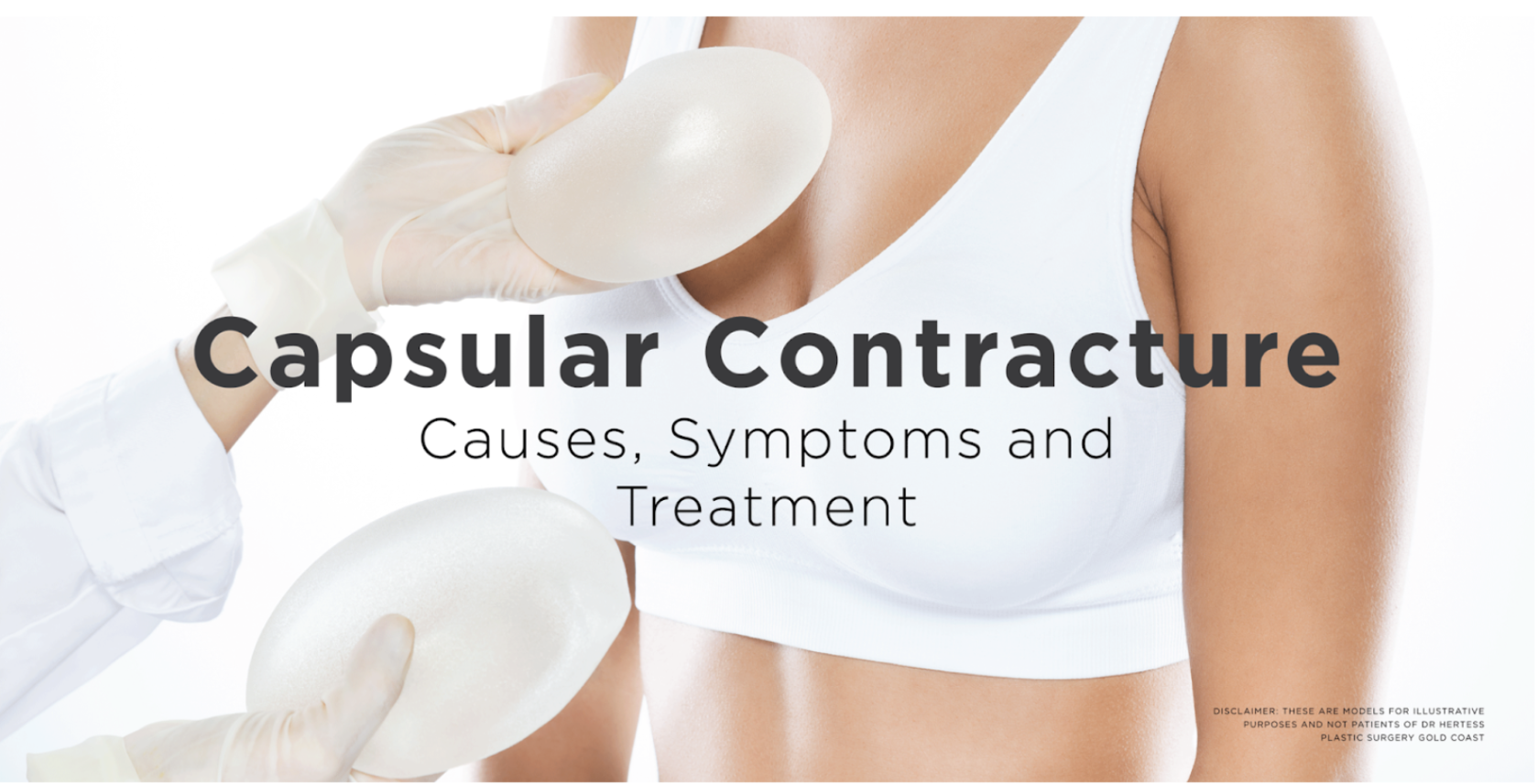Capsular Contracture - Causes, Symptoms and Treatment

Capsular contracture is a breast implant complication that occurs when the scar tissue (capsule) surrounding the implant contracts and tightens. Also known as breast contracture and capsular contraction, this is one of the most common breast implant complications affecting approximately 5%-10% of breast augmentation patients. If you have hardened breast implants and are wondering what to do, you're not alone. This blog aims to answer all of your questions so you can make an informed decision about your next steps.
Dr Hertess is a female plastic surgeon on the Gold Coast who is experienced in the diagnosis and treatment of breast capsular contracture. She is also well versed in all breast surgeries, including breast augmentation and revision surgery.
What is Capsular Contracture?
Following a breast augmentation procedure, your body naturally forms a capsule of scar tissue around the new implant to protect it. This is a standard and healthy response, it’s the body's way of creating a snug, protective pocket.
However, capsular contracture occurs when this scar tissue tightens excessively around the implant, leading to discomfort, appearance changes, and sometimes pain in the affected breast.
It’s important to understand that while the formation of a breast implant capsule is a normal part of the healing process, the contraction—that tightening of the capsule—is what can cause issues, and requires further attention or treatment.
Image 1: Capsular contracture of right breast implant. Real patient of Dr. Isolde Hertess Specialist Plastic Surgeon.
Causes of Capsular Contracture
Capsular contracture is a result of the body's natural immune response to a foreign object. The most common causes of capsular contracture include:
Blood, Bruising, or Infection
Blood accumulation, bruising, or infections around the implant area can trigger an inflammatory response. The inflammation causes the capsule to become thicker and that forms tight scar tissue.
Older Implant Designs
Implants with a sticky shell or "gel bleed" were found to elicit a more significant inflammatory reaction, contributing to a higher rate of capsular contracture. This is because the body detects small drops of silicone gel, and in response forms more scar tissue to protect the body.
Implant Failure
Leakage or rupture of the implant is the most common cause of capsular contracture. This is because it causes a natural reaction to the foreign material (silicone) to stop it spreading within the body.
Capsular Contracture Symptoms
Breast implant contracture can manifest in several ways. The most common capsular contracture signs and symptoms include:
- Feeling of Tightness: Your breast may feel unusually tight or like it's being squeezed. This sensation is due to the scar tissue constricting around your implant.
- Breast Hardening: The affected breast might feel firmer to the touch than usual, differing significantly from its normal softness or from the other breast.
- Discomfort or Pain: You may experience a range of discomfort or outright pain in the affected breast, which can interfere with daily activities or rest.
- Visible Changes in Shape or Position: A noticeable alteration in the way your breast looks or sits can also be a tell-tale sign of capsular contracture. It might seem higher, distorted, or different in size compared to how it was post-surgery or compared to the other breast.
Keep in mind that it's completely normal to have some initial changes as your body adjusts post-surgery. However, if you notice any of these symptoms becoming persistent, it might be a good idea to consult with your surgeon for advice and possible treatment options.
How to Diagnose Capsular Contraction
Typically your surgeon will be able to recognise the condition, however diagnosing capsular contracture may require some further testing. Your surgeon will likely use a combination of the following methods to get a clear understanding of what's going on:
- MRI (Magnetic Resonance Imaging): This detailed imaging technique offers a clear, in-depth look at both the implant and the surrounding scar tissue, helping to identify the extent of capsular contracture.
- Mammography: Especially useful for detecting any changes in the breast tissue, mammography can provide valuable insights, although it's less commonly used for capsular contracture specifically.
- Ultrasound for Capsular Contracture: A non-invasive option, ultrasound uses sound waves to create images of your breast. It's particularly helpful for examining the soft tissues around your implant.
With these tools, Dr Hertess can accurately diagnose capsular contracture breast implants, guiding you towards the best treatment options.
Grades of Capsulated Implants
The Baker Grading Scale is a widely used method for assessing the severity of capsular contracture in patients with breast implants. This baker capsular contracture scale helps surgeons classify the extent of the contraction and decide on the best course of action for treatment. Here's a brief overview of the scale:
Baker 1 Capsular Contracture
This stage is the ideal scenario where the breast appears natural and soft, essentially indistinguishable from a breast without an implant.
There's no sign of capsular contracture at this level.
Baker 2 Capsular Contracture
At this level, the breast may still look normal, but it starts to feel a bit firmer than usual.
Although there are signs of contracture, it typically doesn't require treatment unless the firmness is a concern for the patient.
Baker 3 Capsular Contracture
This grade is when the contraction becomes more noticeable.
The breast not only feels hard but also begins to appear abnormal. Patients may start experiencing discomfort due to the tightness of the scar tissue around the implant.
Baker 4 Capsular Contracture
The most severe form of capsular contracture.
The breast is hard, visibly distorted, and often painful. This grade usually necessitates treatment, which might include surgery or other methods to relieve symptoms and improve the breast's appearance.
Capsular Contracture Treatment
Treatment options depend on a few factors. It's first important to know what's happening with the implant and why is the body reacting. It may be due to a rupture, leak, a foreign object that your body doesn't want to accept or an immune response against the implant.
The implant needs to be dealt with before the capsule. Regardless, capsular contracture surgery is required to alleviate the symptoms of this complication.
Treatment options include:
Remove the Breast Implant (with or without replacement)
Breast Implant Replacement
During breast implant replacement surgery, the old capsule is removed and a new implant is put in. The body then forms a new capsule within 24 hours, which ideally remains thin rather than contracts against it.
In some cases, it may be recommended to change the brand of breast implant to mitigate the risk of recurrence. Typically, the risk of recurrent capsular contracture is 3-20%.
If capsular contracture reoccurs after replacement surgery, then Dr Hertess recommends the complete removal of breast implants.
Removal of Breast Implants
During breast implant removal surgery, the entire implant is removed along with the capsule to alleviate symptoms. This option may be recommended for patients who no longer wish to have implants or if capsular contracture reoccurs after replacement surgery.
 Image 2: Replacement of breast implants with capsular contracture. Implants used were Motiva Round Plus 450cc. Real patient results by Dr. Isolde Hertess Specialist Plastic Surgeon.
Image 2: Replacement of breast implants with capsular contracture. Implants used were Motiva Round Plus 450cc. Real patient results by Dr. Isolde Hertess Specialist Plastic Surgeon.
Capsule Removal (Capsulotomy)
This procedure refers to the surgical release of scar tissue around the breast implant.
In cases where the capsule is contracted on the lower edge and the implant itself is fine, a capsulotomy is performed to release the capsule. This allows the implant to fall back into position and a new capsule will form in the desired position.
Complete Capsulectomy or En Bloc
Capsulectomy surgery relates to the surgical removal of excess scar tissue. En bloc refers to removal of scar tissue in cases where ALCL has been detected.
If you have concerns about hardened breast implants, it's recommended that you see Dr Hertess for advice and appropriate treatment.
Minimising Risk
A commonly asked question is "How do I avoid capsular contracture?" One of the most effective methods to minimise the risks of capsular contracture is to ensure proper postoperative care.
There are a few ways you can do this:
Breast Self-Massage
Massaging your breast implants after surgery can maintain the softness of the capsule and reduce the risk of contracture. Most plastic surgeons recommend routine self-massage for the lifetime of the breast implants.
Avoid Heavy Lifting After Surgery
As part of your surgery aftercare, avoiding heavy lifting after surgery is crucial. Engaging in strenuous activities or lifting heavy objects can strain your body and increase the risk of unwanted complications including capsular contracture.
Choose Modern Implants
New breast implants come with a dry shell surface that is less likely to cause an inflammatory response. This is because they cause less of a reaction in the body. Studies show that these improvements have significantly reduced the occurrence of capsular contracture.
FAQS
What are the signs of capsular contracture?
Signs of capsular contracture include:
- breast implant hardening
- distorted breast appearance
- discomfort or pain in the breasts
Can capsular contracture go away on its own?
Unfortunately, no. Capsular contracture is a medical complication that requires surgical treatment to alleviate symptoms and prevent further complications.
How do you fix capsular contracture?
Capsular contracture surgery is required to correct contracted breast implants.
Is it OK to live with capsular contracture?
If you are experiencing no discomfort, pain, or visible distortion of the breast, then it's ok to live with this condition. However, as it can get worse with time, it's recommended to seek treatment for this complication.
Can capsular contracture come back after surgery?
Yes, there is a chance that capsular contracture may recur even after corrective surgery. If it reoccurs, then complete removal of breast implants is recommended.
Can you stop capsular contracture once it starts?
This condition typically gets worse with time, so it's recommended to seek treatment as soon as symptoms appear.
What does capsular contracture pain feel like?
Pain or discomfort associated with capsular contracture can feel different for each individual. Some may experience a tightening sensation, while others may feel sharp pains. It's best to consult with Dr Hertess for an accurate diagnosis and treatment plan.
When is capsular contracture most likely to occur?
Capsular contracture can develop at any time after breast implant surgery. However, it's more likely to occur within the first two years after surgery.
How common is capsular contracture?
Capsular contracture occurs in approximately 10% of breast augmentation patients. However, with modern implant improvements and proper postoperative care, this complication can be significantly reduced.
Conclusion
Capsular contracture is a common risk of breast implant surgery that can cause discomfort and change the way your breasts look. It's important to seek treatment from an experienced plastic surgeon like Dr Hertess. She can assess the extent of the contracture and then guide you towards the right treatment.



